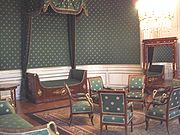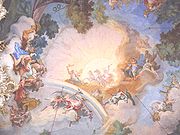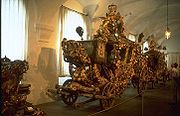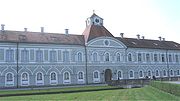
Nymphenburg Palace
Encyclopedia

Nymph
A nymph in Greek mythology is a female minor nature deity typically associated with a particular location or landform. Different from gods, nymphs are generally regarded as divine spirits who animate nature, and are usually depicted as beautiful, young nubile maidens who love to dance and sing;...
's Castle", is a Baroque
Baroque
The Baroque is a period and the style that used exaggerated motion and clear, easily interpreted detail to produce drama, tension, exuberance, and grandeur in sculpture, painting, literature, dance, and music...
palace
Palace
A palace is a grand residence, especially a royal residence or the home of a head of state or some other high-ranking dignitary, such as a bishop or archbishop. The word itself is derived from the Latin name Palātium, for Palatine Hill, one of the seven hills in Rome. In many parts of Europe, the...
in Munich
Munich
Munich The city's motto is "" . Before 2006, it was "Weltstadt mit Herz" . Its native name, , is derived from the Old High German Munichen, meaning "by the monks' place". The city's name derives from the monks of the Benedictine order who founded the city; hence the monk depicted on the city's coat...
, Bavaria
Bavaria
Bavaria, formally the Free State of Bavaria is a state of Germany, located in the southeast of Germany. With an area of , it is the largest state by area, forming almost 20% of the total land area of Germany...
, southern Germany
Germany
Germany , officially the Federal Republic of Germany , is a federal parliamentary republic in Europe. The country consists of 16 states while the capital and largest city is Berlin. Germany covers an area of 357,021 km2 and has a largely temperate seasonal climate...
. The palace was the main summer residence of the rulers of Bavaria.
History
_020.jpg)
Ferdinand Maria, Elector of Bavaria
Ferdinand Maria, Elector of Bavaria was a Wittelsbach ruler of Bavaria and an elector of the Holy Roman Empire from 1651 to 1679.-Biography:He was born in Munich...
and Henriette Adelaide of Savoy
Henriette Adelaide of Savoy
Henriette Adelaide of Savoy , was the wife of the Ferdinand Maria, Elector of Bavaria...
to the designs of the Italian architect Agostino Barelli
Agostino Barelli
Agostino Barelli was an Italian architect of the Baroque.Barelli was invited to Munich by Henriette Adelaide of Savoy to construct the Theatinerkirche in 1664. The work was cowded by conflicts with the construction supervisor Spinelli. Barelli created also the draft for Nymphenburg Palace in 1664...
in 1664 after the birth of their son Maximilian II Emanuel
Maximilian II Emanuel, Elector of Bavaria
Maximilian II , also known as Max Emanuel or Maximilian Emanuel, was a Wittelsbach ruler of Bavaria and an elector of the Holy Roman Empire. He was also the last Governor of the Spanish Netherlands and duke of Luxembourg...
. The central pavilion was completed in 1675.
Starting in 1701, Max Emanuel, the heir to Bavaria, a souvereign electorate of the Holy Roman Empire, conducted a systematic extension of the palace. Two pavilions were added each in the south and north of Barelli's palace by Enrico Zucalli and Giovanni Antonio Viscardi
Giovanni Antonio Viscardi
Giovanni Antonio Viscardi was a Swiss architect of the baroque, who worked mostly in Bavaria....
. Later, the south section of the palace was further extended to form the court stables. As a balance, the orangerie was added to the north. Finally, a grand circle (the Schlossrondell) with baroque mansions (the so-called Kavaliershäuschen - cavalier's lodges) was erected under Max Emanuel's son Holy Roman Emperor Charles VII Albert
Charles VII, Holy Roman Emperor
Charles VII Albert a member of the Wittelsbach family, was Prince-elector of Bavaria from 1726 and Holy Roman Emperor from 24 January 1742 until his death in 1745...
. Two of the latter's children were born here; Maria Antonia
Maria Antonia Walpurgis of Bavaria
Maria Antonia, Princess of Bavaria , Electress of Saxony, was a German composer, singer, harpsichordist and patron, known particularly for her operas Il trionfo della fedeltà and Talestri, regina delle amazoni . She was also the Regent of Saxony in 1763-1768...
(future Electress of Saxony) in 1724 and Maria Anna Josepha
Duchess Maria Anna Josepha of Bavaria
Maria Anna Josepha of Bavaria was a Duchess of Bavaria by birth and Margravine of Baden-Baden by marriage. She was nicknamed the savior of Bavaria. She is also known as Maria Josepha and is sometimes styled as a princess of Bavaria.-Biography:Maria Anna Josepha was born at the Nymphenburg Palace...
(future Margravine of Baden-Baden) in 1734.

Joseph Effner
Joseph Effner was a German architect and decorator.Effner was born in Dachau as a son of the court gardener Christian Öffner. Effner accompanied the elector of Bavaria Max Emanuel to Bruxelles. In 1706 Effner was retrained by Gabriel Germain Boffrand in Paris. Here he changed his family name to...
redesigned the facade of the center pavilion in French baroque style with pilasters in 1716. In 1826 Leo von Klenze
Leo von Klenze
Leo von Klenze was a German neoclassicist architect, painter and writer...
removed its gables with the electoral coat of arms and created an attic decoration
Attic style
In classical architecture, the term attic refers to a story or low wall above the cornice of a classical façade. This usage originated in the 17th century from the use of Attica style pilasters as adornments on the top story's façade...
directly under the roof instead.
With the Treaty of Nymphenburg signed in July 1741, Charles Albert allied with France and Spain against Austria. For a long time, the palace was the favourite summer residence of the rulers of Bavaria. King Max I Joseph died there in 1825, and his great-grandson King Ludwig II
Ludwig II of Bavaria
Ludwig II was King of Bavaria from 1864 until shortly before his death. He is sometimes called the Swan King and der Märchenkönig, the Fairy tale King...
was born there in 1845.
Today, Nymphenburg is open to the public, but also continues to be a home and chancery
Chancery (diplomacy)
A 'Chancery' is the type of building that houses a diplomatic mission or embassy. The building can house one or several different nations' missions....
for the head of the house of Wittelsbach
Wittelsbach
The Wittelsbach family is a European royal family and a German dynasty from Bavaria.Members of the family served as Dukes, Electors and Kings of Bavaria , Counts Palatine of the Rhine , Margraves of Brandenburg , Counts of Holland, Hainaut and Zeeland , Elector-Archbishops of Cologne , Dukes of...
, currently Franz, Duke of Bavaria
Franz, Duke of Bavaria
Franz Bonaventura Adalbert Maria Herzog von Bayern , styled as His Royal Highness The Duke of Bavaria, is head of the Wittelsbach family, the former ruling family of the Kingdom of Bavaria...
. To Jacobites
Jacobitism
Jacobitism was the political movement in Britain dedicated to the restoration of the Stuart kings to the thrones of England, Scotland, later the Kingdom of Great Britain, and the Kingdom of Ireland...
, who trace the line of legitimate British monarchy down through the legal heirs of James II of England
James II of England
James II & VII was King of England and King of Ireland as James II and King of Scotland as James VII, from 6 February 1685. He was the last Catholic monarch to reign over the Kingdoms of England, Scotland, and Ireland...
, the head of the house of Wittelsbach is the legitimate heir
Jacobite succession
The Jacobite succession is the line through which the crown in pretence of England and Scotland has descended since the flight of James II & VII from London at the time of the Glorious Revolution...
of the Stuart claims to the throne of the United Kingdom of Great Britain and Northern Ireland, which claim is not, however, currently being actively pursued.
The Palace

Johann Baptist Zimmermann
Johann Baptist Zimmermann was a German painter and a prime stucco plasterer during the Baroque.Zimmermann was born in Gaispoint, Wessobrunn. He and his brother Dominikus Zimmermann were descended from an artist family of the Wessobrunner School...
and F. Zimmermann and decorations by François de Cuvilliés
François de Cuvilliés
François de Cuvilliés was a Belgian-born Bavarian decorative designer and architect who was instrumental in bringing the Rococo style to the Wittelsbach court at Munich and to Central Europe in general.Cuvilliés was so diminutive in stature that it was as a court dwarf he first came to the notice...
, is an impressive sight. Acting as a grand hall, it occupies over three floors of the central pavilion of the palace.

Gallery of Beauties
The Gallery of Beauties is a collection of 36 portraits of the most beautiful women from the nobility and middle classes of Munich, Germany, painted between 1827 and 1850 and gathered by Ludwig I of Bavaria in the south pavilion of his Nymphenburg Palace in Munich...
of King Ludwig I of Bavaria
Ludwig I of Bavaria
Ludwig I was a German king of Bavaria from 1825 until the 1848 revolutions in the German states.-Crown prince:...
. This pavilion houses also the birthroom of King Ludwig II of Bavaria
Ludwig II of Bavaria
Ludwig II was King of Bavaria from 1864 until shortly before his death. He is sometimes called the Swan King and der Märchenkönig, the Fairy tale King...
.
The court stables contain one of the most important museums of ancient carriages (Marstallmuseum). They also played a part in historical events - the Paris Coronation Coach for example was used for the coronation of Emperor Charles VII in 1742. Among the main attractions of the museum are the magnificent carriages and sleighs of King Ludwig II.
The first floor of the former court stables houses a collection of Nymphenburg porcelain, the factory which, also located in the palace complex, was founded by Maximilian III Joseph
Maximilian III, Elector of Bavaria
Maximilian III Joseph was Prince-elector of the Holy Roman Empire and Duke of Bavaria from 1745 to 1777.-Biography:...
. It's handcrafted products are of legendary kind and quality, nowadays said to be comparable to Augarten and Sèvres only.
The Park
Image:Schlosspark Nymphenburg-Vorschau.png|miniatur|391px|left|Overview: 1 Palace, 2 Grand parterre, 3 Crown prince garden, 4 Amalienburg, 5 Dörfchen with Brunnhaus, 6 Badenburg, 7 Monopteros, 8 Marble cascade, 9 Pagodenburg, 10 Magdalenenklause, 11 Botanical Garden
default
The 200 hectares (494.2 acre) park, once an Italian garden (1671), which was enlarged and rearranged in French style by Dominique Girard
Dominique Girard (architect)
Dominique Girard was a seventeenth century French architect.He was a pupil of André Le Nôtre....
, a pupil of Le Notre
André Le Nôtre
André Le Nôtre was a French landscape architect and the principal gardener of King Louis XIV of France...
, was finally redone in the English manner during the early 19th century by Friedrich Ludwig von Sckell
Friedrich Ludwig von Sckell
Friedrich Ludwig von Sckell was a German landscape gardener from Weilburg an der Lahn.Sckell was trained in the Court Market Garden in Schwetzingen near Mannheim and worked after his apprenticeship in Bruchsal, Paris, and Versailles. From 1773 to 1777, he was in England busying himself with...
, on behalf of prince-elector Charles Theodore
Charles Theodore, Elector of Bavaria
Charles Theodore, Prince-Elector, Count Palatine and Duke of Bavaria reigned as Prince-Elector and Count palatine from 1742, as Duke of Jülich and Berg from 1742 and also as Prince-Elector and Duke of Bavaria from 1777, until his death...
. von Sckell was also the creator of the English Garden in Munich. He preserved the main elements of the Baroque garden (such as the grand parterre). The park is bisected by a long canal along the principle axis which leads from the palace to the marble cascade (decorated with stone figures of Greek gods) in the west. The garden wall (1730–1735) saves several Ha-ha effects.
Two lakes are situated on both sides of the canal. The "Dörfchen" was created under Maximilian III Joseph as Petit hameau
Petit hameau
The Hameau de la Reine |Hamlet]]) is a rustic retreat in the park of the Château de Versailles built for Marie Antoinette between 1785 and 1792 near the Petit Trianon in the Yvelines, France...
. The "Salettl" (1799), a cottage with its little garden nearby close to the former menagerie served as attraction for the children of Maximilian IV Joseph.
The fountains in front of the palace and in the garden parterre continue to be operated by the water powered Pumping Stations
Pumping Stations at the Nymphenburg Palace
The Pumping Stations at the Nymphenburg Palace provide water at sufficient pressure to operate the fountains in the park and in front of the Nymphenburg Palace in Munich, Germany. The original water-powered pumping stations have been in continuous operation for more than 200 years...
built between 1803 and 1808.
Within the park, a number of pavilions were built:
- the Pagodenburg (1716–1719) - an octagonal, two story pavilion with DelftDelftDelft is a city and municipality in the province of South Holland , the Netherlands. It is located between Rotterdam and The Hague....
tile decoration downstairs and ChinoiserieChinoiserieChinoiserie, a French term, signifying "Chinese-esque", and pronounced ) refers to a recurring theme in European artistic styles since the seventeenth century, which reflect Chinese artistic influences...
upstairs. It was built by Joseph EffnerJoseph EffnerJoseph Effner was a German architect and decorator.Effner was born in Dachau as a son of the court gardener Christian Öffner. Effner accompanied the elector of Bavaria Max Emanuel to Bruxelles. In 1706 Effner was retrained by Gabriel Germain Boffrand in Paris. Here he changed his family name to...
. - the Badenburg (1719–1721) - a BaroqueBaroque architectureBaroque architecture is a term used to describe the building style of the Baroque era, begun in late sixteenth century Italy, that took the Roman vocabulary of Renaissance architecture and used it in a new rhetorical and theatrical fashion, often to express the triumph of the Catholic Church and...
pavilion also by Joseph Effner. It contains a grand banqueting hall and a very large tiled bath. Some rooms are decorated with various Chinese wallpapers. - the Magdalenenklause - a faux ruin for retreat and meditation, erected between 1725 and 1728.
- the AmalienburgAmalienburgThe Amalienburg is a small hunting lodge in the Nymphenburg Palace of Munich, southern Germany. It was constructed in 1734-1739 by François de Cuvilliés, in Rococo style, for the Holy Roman Emperor Charles VII and his wife, Maria Amalia of Austria....
- a RococoRococoRococo , also referred to as "Late Baroque", is an 18th-century style which developed as Baroque artists gave up their symmetry and became increasingly ornate, florid, and playful...
hunting lodge constructed in 1734-1739 by François de CuvilliésFrançois de CuvilliésFrançois de Cuvilliés was a Belgian-born Bavarian decorative designer and architect who was instrumental in bringing the Rococo style to the Wittelsbach court at Munich and to Central Europe in general.Cuvilliés was so diminutive in stature that it was as a court dwarf he first came to the notice...
for Charles VIICharles VII, Holy Roman EmperorCharles VII Albert a member of the Wittelsbach family, was Prince-elector of Bavaria from 1726 and Holy Roman Emperor from 24 January 1742 until his death in 1745...
and his wife, Maria Amalia, including a hall of mirrors and a kennel room for the hunting dogs. The building with its decoration is a definite masterpiece on the climax of European rococo. - the Apollotemple - a neoclassical temple by Leo von KlenzeLeo von KlenzeLeo von Klenze was a German neoclassicist architect, painter and writer...
, erected in 1862-1865
A passage close to the old arboretum
Arboretum
An arboretum in a narrow sense is a collection of trees only. Related collections include a fruticetum , and a viticetum, a collection of vines. More commonly, today, an arboretum is a botanical garden containing living collections of woody plants intended at least partly for scientific study...
in the north of the Grand Parterre leads to the large Botanical Garden
Botanischer Garten München-Nymphenburg
The Botanischer Garten München-Nymphenburg is a botanical garden and arboretum located at Menzinger Straße 65, Munich, Bavaria, Germany...
of Munich.
Tourism


Schleissheim Palace
The Schleissheim Palace actually comprises three palaces in a grand baroque park in the village of Oberschleißheim near Munich, Bavaria, Germany. The palace was the summer residence of the rulers of Bavaria.-Old Schleissheim Palace:...
, but clearly behind the castles of King Ludwig II, especially Neuschwanstein.
Schloss Nymphenburg is accessible by Munich public transport's tram number 17. This line passes through the city centre, including Stachus
Stachus
Stachus is a large square in central Munich, southern Germany. The square has been named officially Karlsplatz in 1797 after the unpopular Charles Theodore, Elector of Bavaria...
and the main train station.
Miscellaneous
The palace and its park were some of the main filming locations of Alain ResnaisAlain Resnais
Alain Resnais is a French film director whose career has extended over more than six decades. After training as a film editor in the mid-1940s, he went on to direct a number of short films which included Nuit et Brouillard , an influential documentary about the Nazi concentration camps.He began...
's 1961 movie
Film
A film, also called a movie or motion picture, is a series of still or moving images. It is produced by recording photographic images with cameras, or by creating images using animation techniques or visual effects...
Last Year at Marienbad
Last Year at Marienbad
L'Année dernière à Marienbad is a 1961 French film directed by Alain Resnais from a screenplay by Alain Robbe-Grillet....
. The Dressage Facility for the equestrian
Equestrian at the 1972 Summer Olympics
The Equestrian Events at the 1972 Summer Olympics in Munich included Show Jumping, Dressage and Eventing. All three disciplines had both individual and team competitions.-Medal summary:-Participating nations:...
events of the 1972 Summer Olympics
1972 Summer Olympics
The 1972 Summer Olympics, officially known as the Games of the XX Olympiad, were an international multi-sport event held in Munich, West Germany, from August 26 to September 11, 1972....
was created in the Nymphenburg park.
The palace serves also as headquarters of the Bavarian Administration of State-Owned Palaces, Gardens and Lakes
Bavarian Administration of State-Owned Palaces, Gardens and Lakes
The Bavarian Administration of State-Owned Palaces, Gardens and Lakes , also known as the Bavarian Palace Department , is a department of the finance ministry of the German state of Bavaria...
.

